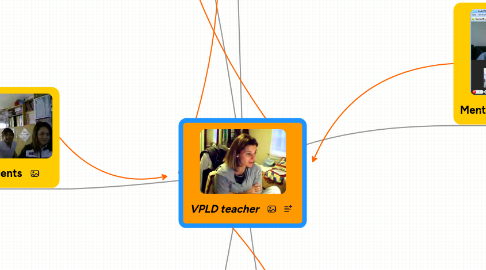
1. Online spaces
1.1. VPLD Community Space
1.1.1. Participant centred
1.1.2. Reflection
1.1.3. Evaluation
1.1.4. Support
1.1.5. Resources
1.1.6. Building rapport
1.1.7. Platform to share ideas, practice & experiences
1.1.8. Development of 'online voice'
1.2. VPLD Moodle
1.2.1. 'Formal' resources / scaffolding
1.2.2. 'Sandpits'
1.2.3. Self-access
1.2.3.1. Variety of media
1.2.3.2. Examples of effective practice
1.2.4. Interactive engagement with resources
1.2.5. Environment models principles of facilitation, design, & evaluation
1.3. VPLD meeting spaces
1.3.1. Skype / Adobe Connect
1.3.2. Monthly meeting with mentor
1.3.3. Group meetings
1.3.4. Community facilitated upskilling sessions
1.3.5. Real time - increased Social Presence
1.4. Personal Learning Environment
2. VPLD community
2.1. Sharing
2.1.1. Ideas
2.1.2. Resources
2.1.3. Personalised
2.2. Reflection
2.3. Teachers as mentors
2.3.1. Self-directed
2.3.2. Self-motivated
2.4. Face-to-face meetings
2.4.1. Participant facilitated
2.4.2. Active / engaged
2.5. Community of professional practitioners
2.5.1. Similar interests and goals
2.5.2. ‘Cross fertilisation’
2.6. Building of relationships
2.6.1. Long-term support
2.6.2. Conversation
2.6.2.1. Comments
2.6.2.2. Discussion
2.6.3. Feedback / critique
2.6.4. Confidence
2.6.5. Shared skills / experience practice
2.6.6. Celebration of alternative points of view
2.7. Genuine, supportive, safe, friendly knowledgeable
2.8. Processes & policies
2.8.1. Agreement about interactions, processes, norms, & 'rules'
2.9. Opportunities to network
2.10. Convenor
3. Students
3.1. Affective factors
3.2. Student learning outcomes
3.2.1. Literacy
3.2.2. Numeracy
3.3. Feedback
3.4. Evaluation
3.5. Level of engagement
3.6. Skills development
3.6.1. ‘Soft skills’
3.6.2. Metacognitive
3.6.3. Self-regulation
3.6.4. Thoughtful discourse
3.6.5. Promotes learning orientations
3.6.6. Digital literacy
3.6.7. Research / enquiry
3.6.8. Communication
3.7. Cultural / global awareness
3.8. Multimedia to scaffold learning
3.9. Create own multimedia objects
3.10. Affective domain outcomes
3.10.1. Motivation
3.10.2. Confidence
3.10.3. Sense of voice
3.10.4. Sense of belonging
3.11. Research
3.12. Goal-oriented assessment
3.13. Strategies to...
3.13.1. Meet needs of traditionally under-served students
3.13.2. Meet the needs / celebrate Pasifika students
3.13.3. Provide choice
3.13.4. Enable Māori to achieve education success as Māori
3.13.5. Meet the needs of students with special education requirements
3.14. Inclusion of whānau & wider communities
4. Wider Education Community
4.1. Global
4.2. Organisations
4.2.1. Formal qualification providers (tertiary)
4.2.2. School communities
4.2.3. VLN
4.2.4. Cluster
4.2.5. Ministry of Education
4.3. Recognition of work & achievement(s)
4.4. Support
4.4.1. Resources
4.4.2. Tools
4.4.3. Funding
4.5. Awareness / sharing effective practice
4.6. Brokerage
5. Mentoring
5.1. Personalised
5.1.1. Engagement
5.1.2. Confidence
5.1.3. Creativity
5.1.4. Participation
5.2. Contextualised
5.2.1. Immersion
5.2.2. ‘Modelling by doing’
5.2.3. Learning by doing
5.3. Self-paced
5.4. Feedback / critique
5.5. Long-term support
5.6. Teacher's learning journey
5.6.1. 'Teacher as Learner'
5.6.2. Identity as educators
5.6.3. Beliefs about learning
5.6.4. Practical skills
5.6.5. Highly-contextualised learning plan
5.6.5.1. Formulate mutually agreed outcomes
5.6.5.2. Recognise their own needs
5.7. Engage in dialogue
5.7.1. Aspects that are effective in their practice
5.7.2. Co-construct new belief-systems
5.8. Role of mentor
5.8.1. * Advisor * Coach * Sounding board * Catalyst * Facilitator of upskilling * Role model * Advocate and champion * Link to wider network * Confidante * Guide / facilitator of guided discovery
6. Barriers
6.1. Time
6.2. Local support
6.2.1. Equipment / tools
6.2.2. Level of technical support
6.2.3. Access to technology
